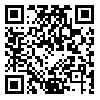Volume 14, Issue 9 (12-2014)
Modares Mechanical Engineering 2014, 14(9): 203-210 |
Back to browse issues page
Download citation:
BibTeX | RIS | EndNote | Medlars | ProCite | Reference Manager | RefWorks
Send citation to:



BibTeX | RIS | EndNote | Medlars | ProCite | Reference Manager | RefWorks
Send citation to:
Dehghan Manshadi M, Pourfatah F. Numerical Study about Role of Ground Effect on Flow Transition fromLaminar to Turbulent Regime at Low Reynolds Numbers. Modares Mechanical Engineering 2014; 14 (9) :203-210
URL: http://mme.modares.ac.ir/article-15-8963-en.html
URL: http://mme.modares.ac.ir/article-15-8963-en.html
Abstract: (7017 Views)
This study focuses on transition of laminar to turbulent flow around a symmetrical airfoil at a low Reynolds number in free flow and flow near the ground at different angles of attack. Finite volume method is adopted to solve the unsteady Reynolds-averaged Navier–Stokes (RANS) equation. Flow around the symmetrical airfoil SD8020 at a low Reynolds number (4000) at 5 and 8 degree angle attack has been simulated in free stream and near the groundnumerically. Current numerical result is compared with other’s experiment and numerical result in free flow at low Reynolds number and flow in ground effect that good agreement has been obtained in aerodynamic coefficient prediction. SIMPLEC method is used for pressure and velocity coupling and flow equations discrete with Quick method. Transition-SST model is used for modeling turbulence of flow. Result shows that the current numerical method can detect adverse pressure gradient, laminar separation bubble and transition of laminar flow to turbulent. According to the result, in ground effect location of laminar separation bubble, length of bubble and location of transition is moved to leading edge and pressure distribution is effected by location of laminar separation bubble.
Article Type: Research Article |
Subject:
Aerodynamics|Turbulance|CFD
Received: 2014/02/17 | Accepted: 2014/03/25 | Published: 2014/09/24
Received: 2014/02/17 | Accepted: 2014/03/25 | Published: 2014/09/24
| Rights and permissions | |
 |
This work is licensed under a Creative Commons Attribution-NonCommercial 4.0 International License. |







